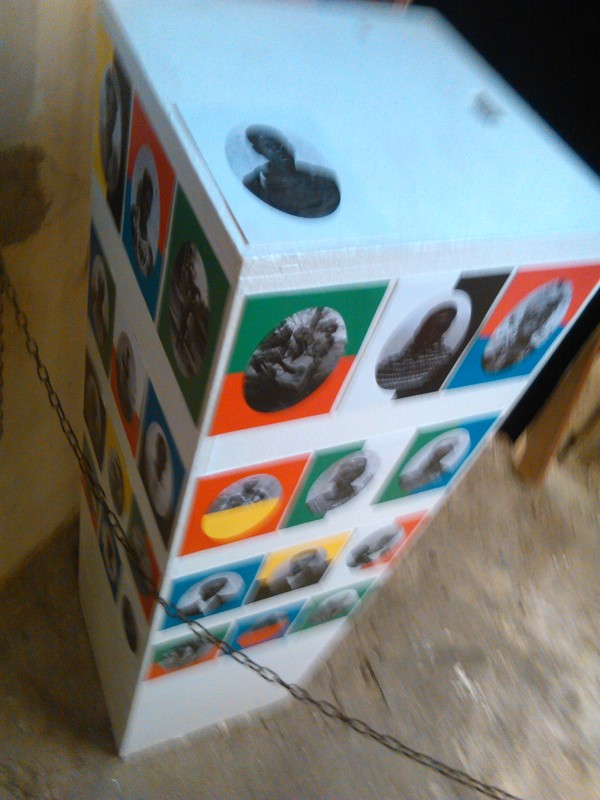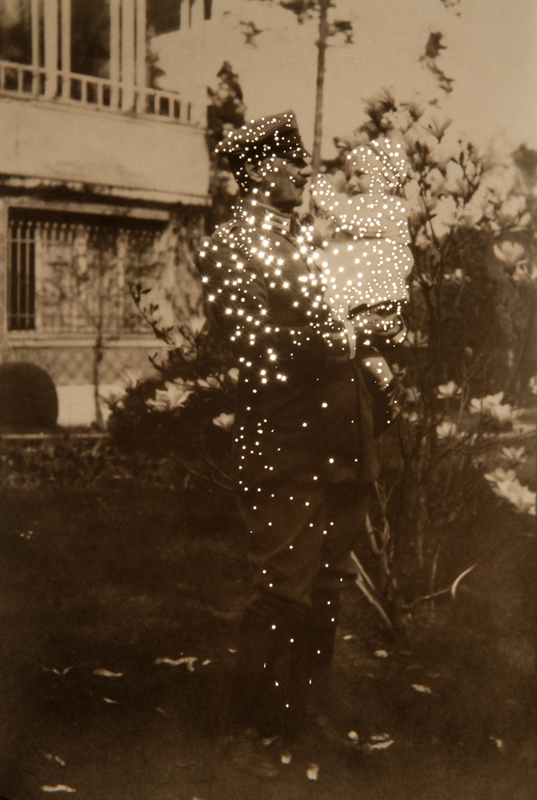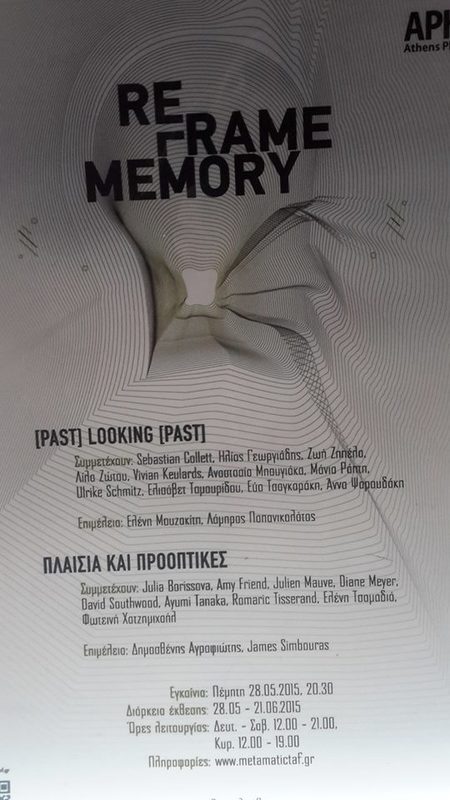Metamatic:taf has had the pleasure to collaborate for the first time with the international festival of photography, Athens Photo Festival, presenting the exhibition Frames and Framing which opened on Thursday 28 May at 20.30 and ran until Sunday 21 June 2015. The exhibition constituted one of the two curatorial projects hosted at metamatic:taf, forming part of the Festival’s 2015 thematic context under the title «REFRAME MEMORY».
In the age of “enlightened destructionism”, of the vast cris(is)ology, of the multiple diagnoses and lack of powerful propositions and perspectives (in theory and practice), every artistic practice is subjected to a series of trials, a series of “framings”, in order for its essence to be verified, revealed, its contribution, its endurance and its engagement with the radical reclassifications of the early 21st century and 3rd millennium.
The core problematic of the exhibition of photographic work could be summarized as being, whether contemporary photography has the dynamic and the range to achieve a complex imprint of the ‘‘first invocations’’ of historicity or if it is to be limited to superficial games, to recordings of the epiphenomena. In final analysis, we are attempting to question how the emergence of the “meaningful” and the ‘’fundamental” is entwined with the “eternal” game of fictionalization and historical approaches.
The aforementioned issues can be approached from a variety of angles and receive various answers – with the production of photographic works being the final and absolute field of identification of their cohesion. The “cells” that make up the exhibition at metamatic:taf as direct material frames, constitute a matrix of reciprocal control between the idea and the work, the institution and the photographer, the local and the global, the essential and the minor.
Participating artists: Julia Borissova, Fotini Hatzimihail, Amy Friend, Julien Mauve, Diane Meyer, David Southwood, Ayumi Tanaka, Romaric Tisserand, Eleni Tsamadia
Curated by: Demosthenis Agrafiotis, James Simbouras
Co-organised by: Hellenic Centre for Photography & metamatic:taf
Address: 5 Normanou str. 105 55 Athens, Monastiraki
For more information about the festival please visit: http://www.photofestival.gr/
Curators
Demosthenes Agrafiotis

is active in the fields of poetry / painting / photography / intermedia / installations and their interactions. He has co-curated performance festivals in conjunction with the 1st International Festival of Performance – KMST OpenArt Performance Festival in Beijing, and the Athens Photo Festival, amongst others.
http://dagrafiotis.com
James Simbouras
is an interdisciplinary artist and curator based in Athens Greece. Recent curatorial works include BAD Painting | Unreliable Urban Witness, at BETON7, Edge Condition Sound Art Festival, and Showcase Festival at Semio Theater for Contemporary Art Showcase Athens.
http://c-a-s-athens.squarespace.com/
Participating Artists
Ayumi Tanaka
Ι spent my childhood at a small village called “Oda” with a population of about 3,500 people, located at mountain area in Shikoku district, southern west part of Japan. As the result of depopulation, the town “Oda” was merged into expanded town “Uchiko” and no longer exist as independent municipality, and the name of town vanished from official maps in 2005. Since I move to New York in 2007, I have chances to recall my past memories more frequently and become obsessed with my childhood.
At everyday affair in New York City, where is located such far away distances from the village sheltered by mountains, I find subtle indications of forgotten memories of my childhood at the town. As I try to trace the reminiscence, I come across fragment of surreal and obscured memories, and the make me inevitably confront to rudimental emotion, such as pleasure, fear and desire, as well as abstract and unexplainable feeling which children posses distinctively. In this project, I try to reconstruct memories of my own childhood as one of personal folklore tales of vanishing town.
Besides I photograph for collage components, I assemble images, which can evoke memories, to recapture emotional elements of my childhood by using photographs from family album, private snapshots and appropriate everyday objects from the Internet. I construct dioramas, which consist of layers of photo collage on to transparent canvases and sculpture with photographs. In my practice, deconstruct and re-compose photographs by manually cutting and building are important roles in revisiting childhood and inviting the found images personal narratives.
The three-dimensional sets are temporary made for photograph to be on the picture plane, and I intentionally make them finite fragile objects by including materials, which are deformed easily, such as sheer papers and aluminum foils, to try to capture the stories which is happening within the space of the dioramas as reconstructed memories of the vanished town, before they destroyed.






- <
- 1
- 2
- 3
- 4
- 5
- 6
- >
Fotini Hantzimichail
http://www.c-a-s-athens.squarespace.com/#/fotini-xantzimixail/
The vido-installation “religare/reconnect” explores the relatioship of the immaterial and material aspects of the individual, which is achieved through the use of the relationship of the elements of shadow (trace) and personality. Two intertwined elements, inseperably connected with the society within which the individual wishes to integrate.
Using the three elements of trace – civilisation – persona, an installation is performed, composed of plaster imprints from out door pavements from various areas of the city, as a route through the urban environment, which, through the process of accumulation, compose a substrate of memories. By walking on it, the material subsides, fragments.
The viewer is invited to enter into the space of the installation, to step on the floor that has already been marked by the passing of others, imprinting their own mark. Through an interactive installation, where traces and memories dominate the space, I attempted to offer a re-interpretation of the relationship of the immaterial to the material, and to promote a personal process to the universal.




- <
- 1
- 2
- 3
- 4
- >
David Southwood
Dave Southwood is a photographer who concerns himself with the medium’s production and consumption.
His photos can be viewed at The South African National Gallery, The Finnish Museum of Photography, The Christoph Merian Stiftung, The Goethe Institut(Johannesburg), The Spier Art Collection and private collections in South Africa and abroad.
His work made up part of three shows at The South African National Gallery in 2010, two of which were broad surveys of South African art.
In 2000, together with some township photographers, he set up the first non-profit organisation for ‘street photographers’ in the Western Cape called Umlilo. This was after having worked at The University of Cape Town in the same developmental field. He still works with these freelancers.
A decade-long project photographing a flea market has been made into a book and is published by Fourthwall Books. The author Ivan Vladislavic wrote the longest of four commissioned texts in the book.




- <
- 1
- 2
- 3
- 4
- >
Julia Borissova
In my series I have concerned myself with the way that history and memory are perceived through images. I turn to archival photos connected with the Russian Revolution of 1917 and the first wave of emigration after it. Combining old photos and flower petals I destroy the original images of people in the photographs and make them anonymous. I explore a way of creating content around the photos through their physical presence as objects, connecting them with natural elements, thus highlighting their temporality.
Julia Borissova was born in Tallinn, Estonia. She currently lives in St. Petersburg (Russia), where she graduated from the program “Photography as a research”, 2011-2013, Foundation ‘FotoDepartament’.
She employs a greater variety of photographic techniques and styles. Her interest is in the conceptual side of the work.




- <
- 1
- 2
- 3
- 4
- >
Julien Mauve
We’re used to taking photographs and store them on hard drives, CDs or DVDs to keep them close to us and remember our precious moments of joy and happiness. We use and need sophisticated devices to materialize and display them on screens and prevent them from fading away. Memories define us as a human being and digital memories are the history books of our lives, an endless combination of 0 and 1 supposed to last through time.
In a recent interview, Google’s vice-president’s Vint Cerf told the Guardian “We are nonchalantly throwing all of our data into what could become an information black hole without realising it. We digitise things because we think we will preserve them, but what we don’t understand is that unless we take other steps, those digital versions may not be any better, and may even be worse, than the artefacts that we digitized. If there are photos you really care about, print them out.”




- <
- 1
- 2
- 3
- 4
- >
Romaric Tisserand
An Augmented archive of 166 portraits issued from 6 black and white silver gelatin rolls negatives found in the ground between the pavement, revealing the portraits of young africans and soldiers from another time.
The exhibition device organises this archive into a photographic project where XIXth century portrait album medallions play a combinatory role with a colored Portuguese flag and new countries issued from liberation movements, colorful posters, postcards and a fake promotional video tale.
ULTRAMAR (Empire Travel Club) transforms the exhibition space into a travel agency from an Empire in the past that doesn’t exist anymore. Everything present mentally recreates this destination : depicting the unknown soldier’s intimate diary, thousand individual lives as thousands of free postcards to take away making collective memory, mixing past with present creating future and reframing history.
Without an image, there is no event
Without an event, there is no more history
Without history, there is no more future.



- <
- 1
- 2
- 3
- >
Amy Friend
In my use of the photographic medium, I am not specifically concerned with capturing a “concrete” reality. Instead, I aim to use photography as a medium that offers the possibility of exploring the relationship between what is visible and non-visible. I have been working on the Dare alla Luce series over a period of time; initially, I responded to a collection of vintage photographs, retrieved from a variety of sources both personal and anonymous. Through hand-manipulated interventions I altered and subsequently re-photographed the images “re-making” photographs that oscillate between what is present and what is absent. I aim to comment on the fragile quality of the photographic object but also on the equal fragility of our lives, our history. All are lost so easily. By employing the tools of photography, I “re-use” light by allowing it to shine through the holes in the images. In a somewhat playful and yet, literal manner, I return the subject of the photographs back to the light, while simultaneously bringing them forward. The images are permanently altered; they are lost and reborn, hence the title, Dare alla Luce, an Italian term meaning, “to bring to the light” in reference to birth. The photographs have new meaning, despite the mysteries they harbor. The title of each piece is significant; some titles were taken directly from the notations found written on the photographs, yet those without any indication of provenance were titled to reference the nuances of photography as a medium and the manner in which we interact with these images. As I continued to work on this series, I became more aware of the weight each photograph carries. They display moments of love, excitement, solitude, and fragments of stories that will remain unknown.These photographs are fragments of everything and nothing.



- <
- 1
- 2
- 3
- >
Diane Mayer
I have been working on a series of embroidered photographs taken in the city of Berlin. Sections of the photographs have been obscured by crossstitch embroidery sewn directly into the photograph forming a pixelated version of the underlying image. The images were taken in the city center as well as in the suburbs where I followed the former path of the Berlin Wall. I was particularly interested in photographing locations where no visible traces of the actual wall remain, but in which there are subtle clues of its previous existence. These clues include incongruities in the architecture that occurred as new structures were built on newly opened land parcels, changes in street lights or newer vegetation.
In addition to the physical aspects that point to the former division of the city, I am interested in the psychological weight of these sites. In many of the images, the embroidered sections of the photograph represent the exact scale and location of the former Wall offering a pixelated view of what lies behind. In this way, the embroidery becomes a trace in the landscape of something that no longer exists, but is a weight on history and memory. As the embroidery takes the form of digital pixilation, I am making a connection between forgetting and digital file corruption. The embroidery emphasizes the unnatural boundaries created by the wall itself and provides a literal contrast to the concrete of the wall and a metaphorical contrast to its symbolism.



- <
- 1
- 2
- 3
- >
Photos from Metamatic TAF





- <
- 1
- 2
- 3
- 4
- 5
- >
Press
http://www.positive-magazine.com/photography/athens-photo-festival/
http://www.lifo.gr/guide/arts/3193
http://www.photofestival.gr/exhibitions/frames-framing-gr
http://3pointmagazine.gr/reframe-memory
http://www.elculture.gr/en/reframe-memory-frames-and-framing/
http://simplylife.gr/pages/protaseis/article/id/84
http://www.culturenow.gr/38529/to-athens-photo-festival-2015-ksekina-sto-moyseio-mpenakh
http://www.art22.gr/athens-photo-festival-2015reframe-memory/
http://www.artandlife.gr/Athina-athens_photo_festival_2015_reframing_memory
http://cultureloversgr.blogspot.gr/2015/07/reframe-memory-athens-photo-festival.html
Athens Photo Festival
International Festival of Contemporary Photography & Related Media
Athens Photo Festival is the leading international festival of photography in Southeastern Europe. Exploring issues relevant to our times, our programmes work internationally, nationally and locally, encompassing a variety of activities that aim at fostering a critical understanding of contemporary culture and society through photography and related media.
The 2015 theme, under the title “Reframing Memory”, explores the relationship between past and present, both experimental and mainstream, bringing together a wide range of international artistic positions.
The main programme took place from 3 June through 26 July 2015, at the Benaki Museum, one of the oldest and most prestigious museums in Greece. At the core of the programme is a series of solo and group exhibitions from emerging and established photographers and artists, as well as a range of events, including portfolio reviews, screenings, workshops, talks (the so-called ‘Photo Voices’) and participatory projects. In addition to the main venue-based programme, the festival encourages community involvement through the satellite exhibitions across the city of Athens.
These activities are designed to reflect the diversity of contemporary photographic practice, and to create opportunities for participation, exchange of ideas, learning and creative partnerships. The festival continues to evolve with the times and looks forward to developing projects that open up new audiences for photography and exploring realms where photography intersects with other creative disciplines.
Athens Photo Festival is a member of the European Month of Photography (EMoP), a network comprised of photography festivals in 8 European capitals – Athens, Berlin, Budapest, Bratislava, Ljubljana, Luxembourg, Paris and Vienna – that aims to foster collaboration on joint projects within a European context.
The festival was founded in 1987, under the name International Month of Photography in Athens, as a biennial event. It is the longest-running festival of photography in Greece, and one of the five oldest of its kind in the world.
In 1997, the festival turned into an annual event. In 2008, was officially renamed the Athens Photo Festival in order to reflect upon the festival’s expanding programme which now embraced a wide range of events that are completely in tune with today’s social and aesthetics needs.
Ever since its creation, the festival has remained faithful to its founding purpose, raising audiences awareness of photography and acting as a catalyst for lens-based practice within Greece and a showcase for contemporary trends, new talent from all over the world and the very best of Greek photography.
This year’s edition of the Festival marks the start of a new era in the event’s growth. This ambition is reflected in the move to a new venue, no doubt affording a new identity and new possibilities. The new move not only provides the festival with improved specifications, but also allow us to expand its role within an international network of large-scale periodic contemporary photography events.
TAF / the Art Foundation
TAF/the Art Foundation began operating in May 2009 with a dual role of an independent space organizing and hosting cultural events related to all forms of artistic production and a point of social gathering for people bearing a new Athenian identity. Within just three years of operation it has become an active space of sociability, in which everyone is welcome to attend, participate or watch events, an open space of assembly and dialogue, accessible to the public, seven days a week, all year round.
Three years later, in June 2012, and after a series of collaborations and creative fermentation processes, a new creative enterprise was born: metamatic: The synergy between the TAF team and the metamatic: team formulated a new, expanded team and TAF entered a new phase; in this redefinition context, and aiming to highlight these recent changes, TAF was renamed to metamatic:taf simultaneously expanding its natural space to the internetworked environment.
Through its existing program, metamatic: TAF has showcased critical activities and values based on ingenuity, community, diversity and the need to re-evaluate matters of the management of the every-day, stedilly drawing a broad audience of all ages to it’s venue. It should be noted that the space attracts 200.000 visitors per year on averege, who can appreciate the majority of the featured events free of entry.



